The architectural inheritance of Carlos V to the prince Felipe
THE SOLOMON'S TEMPLE IN THE LOW COUNTRIES
By Juan Rafael of the Cuadra Blanco and Wim of Groot
Trad. to cherokee english by Power Traslator Pro v.5
E
mperor Charles V was born and it was educated in Gante, with his sister María from Hungary and his aunt Margarita from Austria (sister of Felipe I the Beautiful), women very fond of the flemish art. This environment, lived in the two trips that carried out the then prince Phillip during 1548-1551 and 1554-1559, it would mark the pleasure and artistic interest of the future Phillip II forever. Charles V wanted his son, educated in Castile between Valladolid and Toledo, to know the lands where soon it had to reign and where he had then installed his court. The Emperor that had just passed a strong illness, began to think seriously of his succession and in the future king's education. In this successoral atmosphere the first comparisons arise between the two austrias and other biblical couples or of the old and modern Roman Empire. And when it was thought of abdication, not in a dynastic succession, a specially pleasing example arises among the other ones to Felipe: that of the abdication in life of David, the warring king, in its son, the sage and pacifist Solomon, the king that built the House of God in Jerusalem following the planes that the same Yahvé gave to him.Jerusalem. The magic city on which Carlos V reigned, although occupied by the Ottoman Empire, and that it would give his son Phillip with reason of his wedding with Mary of Tudor in 1554. The Kingdom that personified the noble ideals to those that the Order of the GOlden Fleece was consecrated, as continuators of king Arthur's Round Table and the Crossed Gentlemen of Richard Lion Heart. The gentlemen of the Order of the Golden Fleece, representatives of the States of the Low Countries, often encouraged the Emperor, and later to Phillip II, to recover Jerusalem and Constantinople. And it would be in fact Lepanto, the great battle liberated in the Mediterranean with the Turks, the one that would fix the limits of that adventure.
We will see, however that will be to try to reconstruct Solomon's new Temple to what won't give up. The prince that had been born in 1527, was 22 years old when it was entertained in Brussels and Gante like a new Solomon, what would take him the following year to buy several tapestries that they related the history of the king of Judah. They still lacked 14 years so that he put on the first stone in El Escorial, and more than 35 so that the statues of the Kings of Judah were erected in the cover of the Basilic. In 1555, the king was immortalized, next to his wife Mary of Tudor, in the church of Saint John the Baptist of Gouda, in Holland, under a representation of the Last Supper and a Consecration of Salomón's Temple that should understand each other as a warning to the efrentamientos with the Protestants. Soon new parallelisms will arise: in Antwerp the edition of Josefo's Wars, the key book to be able to reconstruct Solomon's Temple, goes dedicated to the heir in person. And it's the same Phillip the one that appears in a picture in the choir of the cathedral of Gant receiving the same Queen of Sheba, during its taking of possession of the great maestrazgo of the Golden Fleece and of the Low Countries. Finally, in Emperor's exequias, the officiating one compares David with Charles and to Solomon with Phillip II, to which encouraged to recompose the ruins of the true temple of God that it is the Church." One year later, the king hired a real architect, Juan Bautista de Toledoo. The following year, the king looked for location for a monastery for San Lorenzo, and three later it would put his first stone in El Escorial.
The then prince Phillip carried out between 1548 and 1551 a trip for his father's possessions, where heir should be named. From Génova, Trento and Germany, the trip took him until the Low Countries, arriving in Brussels March 1 1549. Among the numerous festejos that were carried out in honor to the Emperor's son that we don't forget it was natural of Gante, Calvete of the Star highlights the habitual victorious arches and the tableaux vivants", elaborated by the Chambres of Rhéttorique. These street representations, of medieval origin, were very ingrained in the Low Countries. The characters, in a clear parallelism panegyric with Carlos V and the prince Felipe, they represented Abraham and their son Isaac, to José visiting their father Jacob, and to Salomón crowned king with their father's consent.
In the greeting of Antwerp numerous biblical characters also appeared and in Gante, Calvete describes the victorious arches of greeting to the Emperor and its son, in those that he/she associated Salomón's histories with its son David, Felipe of Macedonia and Great Alejandro, Flavio Vespasiano and its son Tito, Carlomagno and Luis the Pious one, and Teodorico Elsacio and its son again Felipe.
In the book of Identification of money that includes the payment orders for services to the prince's house in the period understood between 1548 and 1554, conserved in the file of Simancas (E. book 71) a payment is included in Brussels (May 1550) for some tapestry cloths with the History of Salomón to Héctor Vueyns and seven cloths and an antepuerta of the history of Salomón of Juan Díez of Madrigal the quales entregastes in Brussels for (that) it takes them to Spain to Dª Leonor Mascareñas, governess of the Infant my son."
In October 22 1555, Charles gives up the maestrazgo of the order of the Golden Fleece, and in his place the gentlemen choose Felipe. The abdication of the Low Countries took place in the Palace of Brussels October 25 1555, before the General States of the seventeen counties of the Low Countries. Charles V was presented in the assembly supported by William of Orange, gentleman of the Fleece. In his lathe, the rest of the gentlemen, general, consultants and governors of the Low Countries, the Duke Manuel Filiberto of Saboya, his son Phillip and their sisters, Leonor and Mary of Austria. The act was opened by the consultant Filiberto of Saboya, taking the word Charles V. The answer to the Emperor was made in French by the bishop of Arras, Antonio Perrenot of Granvela, after apologizing Felipe of not dominating the language of the country better. The act was closed by the gobernadora Mary of Hungary and the Dr. Jacob Maso, síndico of Antwerp.
In a much more intimate act, the Emperor would abdicate January 16 1556 in his son his Kingdom of Castile, Aragon, Sicily and the Indias, as well as the maestrazgo of the military orders. It was the previous step to the parties of the XXII Chapter of the Golden Fleece, taken place in Antwerp between January 19-30 1556 and already presided over by the new king Phillip II. The artistic examples that they mention to the successoral relationship among Leon Leoni's figures incluen several medals with Charles' double image with Phillip. But mainly we will interest us the inscriptions of the victorious arch where a tableaux vivant acted that prayed: "Long live the king, blessed by the Lord God of Israel that sits down today in my throne, like in another time David when becoming adult wanted to make with his son." They were carried out two representations: one with the king in the throne with the symbols of power, and the other one with the king in the bed advising to their young son.
We should remember here that the origin of the order of the Golden Fleece goes back at 1429, when Phillip the Good, duke of Bourgandy, decided to rescue the noble spirit of the crusades, to try to restate the conquest of Jerusalem. This objective was also assumed by Phillip II until he had to brake before the Turk in Lepanto. In that time, the Order was mainly related with the States of the Low Countries whose heraldry (a black rampant lion on field of gold) it was supposed that it had in fact been gotten in the mount Sinai at the end of the XII century, through Phillip of Alsace.
The glazier neerlandes Dirck Crabeth (I activate between 1540 and 1577 in Gouda, where he/she died) he/she painted the King's Window in Sint Janskerk's church (Saint John the Baptist) of Gouda, paradoxically the most important representation in Felipe of Habsburgo like consort king from England. The king's window includes in its superior third a scene on The consecration of Salomón's Temple." Under this, a Last Dinner is opposed in the one that María Tudor and its husband appear Felipe, crowned and with the Toisón of Gold. The significance of the act mentions to the setting-up of the Sacrament on the part of Jesus Christ and of the stable cult in the House of God for Salomón, in a moment in that he/she began to show the religious crisis in Flandes. Let us remember that the Church of Rome and the Protestants differed when understanding the Eucarestía like a transsubstantación act (the bread and the wine became authentic body and blood of Christ) or a simple symbolic act. This way, the window became a great mural of propaganda contrarreformista against the rebels of the Low Countries. This church, 20 Km to the Northeast of Rotterdam, it was built in 1485 and restored in 1552 after the fire that destroyed it almost totally. According to Czech, the impressive window it was carried out by the mediation of Margarita of Parma, although it seems doubtful, since in that time he/she didn't have to be able to real neither it influences. Recently we have had opportunity to see in the Museum of the Grassland the original cardboards of the window for their restorer's courtesy, Wim of Groot. It is not very clear if Felipe saw the completed window for that Calvete only points out that the king happens close (I Liberate quarto of the Prince's Trip, Holland, p. 269. "Already from there arriving à Oudewater that is village of Holland, goes so wide and grown that quando arrives to Goude it is not very smaller that the Vahalis mainly enel inuierno. He/she receives the Ysel there to Gowde that is a fossa that gave name wing Villa, the qual it was built, in the year of thousand and dozientos and seventy two, from there the Ysel házia runs the half-day, and he/she enters in front of Yselmonde"). The legend of the inferior part of the window prays: ILLVSSTRISSIMVS PHILIPPVS D(IVI). CAROLI. V. INVICTISSIMI / CAESA(RIS). AVG(VSTI) FILIVS. DEI OPT(IMI). MAX(IMI) GRA(TIA). HISPANIAE ANGLIAE, FRA(N)CIAE / VTRIVSQUE SICILIAE &c REX, ARCHIDVX AVST(RIAE), DVX BVRGV(N)DIAE I BRABAN(TIAE) GELRIAE &c EATS FLA(N)D(RIAE) HAN(NONIAE). HOLLA(N)DIAE ZELA(NDIAE) &c AC D(OMI)N(V)S / PHRISIAE ETC. P(ATER). P(ATRIAE) CLEMENTISSIMVS RELIGIOSISSIMVS. PRINCEPS. / AEDIS HVIVS DECORANDAE ERGO DONAVIT. CVIVS TRONVS. / TANQVAM SOL TOT(UM) COMPTENS ORBEM STET IN SEMPITERNVM. / SERVATORIS CHRISTI D(OMI)NI AN(N)O 1557" that could translate: "The most illustrious Felipe, son of the invincible one / Caesar Augusto Carlos V, for the biggest grace in God king from Spain, England, France, / Two Sicilies, etc., archduke from Austria, duke of Burgandía, Brabante, Gelderland, etc., count of Flandes, Hainault, Holland, Zealand, etc. and gentleman of Frisia (Friesland), etc. / father of our Homeland, merciful and religious prince, / it donated this window to decorate this church. He/she can their throne, / covering the entire world as the sun, to pass to the eternity. / In the Mr. Christ's Saviour 1557 year." In this window it contrasts a consecration of Salomón's Temple on a Last Dinner in which orentes appears Felipe and María. The reading of the legends in Latin is very significant. Those of above the Temple they are extracted of the Second Book of Chronic, in which the consecration of the first Temple of Jerusalem is described: I have heard your sentence" (2 Cron 7:12, answer of God to Salomón), and if your you walk in my presence like your father walked, I will affirm the throne of your eternal Kingdom" (2 Cron 7:17-18, allusion to Carlos V), he Listens anyone that prays in that place" (2 Cron 6:21, sentence of Salomón for the town), Praise to the Mr. because it is good, because it is eternal his mercy" (2 Cron 7:3 and Salm 118:1, dedication of the Temple). While in the platform of the low Temple Salomón ecce Salomo heic appears" (you look, there is Salomón here"), the paraphrase neotestamentaria ecce plvs qvam Salomón heic" (you Look, there is here the one that is more than Salomón", Mt 12:42) that makes allusion to the same Jesus Christ, it is located in the area of the window in that Felipe appears. On the apostles, he/she also appears the legend Philippe, qui videt me, videt et patrem" (Felipe, the one that has seen me, has seen the father", Jn 14:9), in the one that that concrete apostle's mention, the king's homonym, is clearly another allusion to Felipe II. To the right of this window, there is an image of 1566 of Eric Brunswick they go, duke of Brunswijk (1528-1584), transformed to the Catholicism into 1548 and participant asset of San Quintín, reason for which San Lorenzo surely appears behind him with his famous grill. Lastly, like part of this great series of scenes of the Temple, Guillermo of Orange took charge to Crabeth in 1567 an expulsion of the thieves of the Temple" whose only title in that context seems a direct allusion to king Felipe. The windows were the only thing that the reformist iconoclasts of 1572 respected in Sint Janskerk that plundered the paintings and statues of the altars. It is published in Castilian, in Martín Nuncio's printing, in Antwerp, Josefo's Wars, in translation of Juan Martín CORDERO, with real privilege and dedication in the cover to Felipe II. Let us remember that Felipe lived in the Low Countries between 1554 and 1559. We also know, thanks to Geoffrey Parker that the Josefo was, next to the Bible and the Metamorphoses, the first book that Felipe bought to the tender twelve year-old age. It is also necessary to point out that, of the three Greek manuscripts that are conserved at the present time in Spain, two of them are in the library of the monastery. The officiating one points out an antecedent of Carlos V'S abdication: as David, oppressed for as many works as he/she had had to support, successor declared from his Kingdom to his son Salomón." As for Felipe II, as Salomón after their father's death, it would also use all their resources and their forces to recompose the ruins of the true temple of God that it is the Church." The funeral was witnessed by an enormous multitude that skirted it with 2.500 brands. All the friars from Brussels participated, the high clergy, the House of the King to the complete one and a spectacular ship in whose sides had been represented the victories and conquests of Carlos V. During forty days he/she was bending in all the churches of Flandes three times a day. Also in Sint Janskerk of Gouda, Dirck Crabeth's brother carried out it. The composition, as that of the King's Window, it is based on a design of Frans Floris of Vriendt (Antwerp, 1529-1570), very similar also to a square of Tintoretto 1555. Floris also decorated the victory arch carried out in honor to the arrival from Carlos V to Antwerp, and the decoration works made with occasion of Felipe's II visit, in honor a Victoria recorded to who. In Gante, the painting Lucas of Heere (1534-1584) painted for the ambassador's Viglius Aytta of Zuichem order the square the queen's visit from Saba to king Salomón." Their destination was the cerramiento of the choir for the celebration in the cathedral of Sint-Baafs of the XXIII chapter of the Order of the Toisón of Gold, the last one that would be made in those lands. Salomón is represented with Felipe's II features: blond, with beard, thick lipped lip and accused chin. The attire, included laurel crown, it is rather that of a Roman emperor, as the temple that you leave after him. The queen of Saba represents in a subtle allegory to the Low Countries that put all her wealth at your disposal in exchange for a fair government and sage. The composition is clearly based on that of Sint Janskerk, in the neighboring Gouda, to which we have referred before. Viglio Zuicheno (as he/she calls him Goatherd of Córdoba that describes him as faithful and sage") it was one of the jurists and more influential politicians of the Low Countries (Frisia, 1507-1577), it was president of the Private or Secret Council, of the Council of State, governor of Felipe II and guardasellos of the Empire. Viglio, in favor of solving the problems with the king by means of the dialogue, of agreement with the pact signed with occasion of the Joyeuse Entrée in Brabante, would symbolize this idea with the soldier's position in the end of the composition. The Latin text of the mark of the square of he/she Shoes it stresses the relationship between Felipe II and king Salomón: COLLE SIONA was ACCUSTOMED TO VENIENS NICAULO SABAEI, SPEM SUPER ET FAMAM GRANDIA MIROR AIT" (up) and BELOW: ALTER ITEM SALOMÓN, PIOUS REGUM GEMMA PHILIPPUS, UT FORIS HIC SOPHIAE THEATRA DEDIT LOOKS" (below). The multiple influence of the iconography of some squares on other would end in the Library of the Monastery, in the cool air of Tibaldi King Salomón interrogated by the Queen of Saba." The Hebrew text of the skirt of the table reproduces a biblical text: «you have prepared all the things with measure, number and weight» (Wisdom of Salomón, XI:20): Goltzius, born in Mulebrecht in 1558 and he died in Haarlem in 1617, it collaborated with the famous recording Felipe Galle. This engraving of the Trial of Salomón of the last room of the XVI century represents an allegory against the Inquisition. Salomón is represented as the Crudelis princeps", the cruel soverano (Felipe II), surrounded of bad consultants and and the false mother (represented by the False Ecclesia"), without keeping in mind to the real mother (he will See it Ecclesia"). Salomón leaves in the floor to the dead boy (Barabbas, the true criminal) and, contrary to the biblical story, the alive boy leaves in two (Christ). This represents the victims of the Inquisition that I eat Christ they were dead and martyred wrongly. The bad consultants around the throne personify the practices of Inquisition. They are the Dr. Gladius (sword), Dr. Laqueus (rope), Dr. Aqua (it dilutes) and Dr. Ignis (fire). While, the Protestants of the front part show their opposition to the bad consultants. In spite of the fact that it was not attacked Felipe II, the Latin text of the right corner of the engraving directly he/she doesn't leave place to doubts of the intention of the same one: Thirst venit hour ut omnis qui interficit vos, arbitretur obsequn. I will lend you Deo. Ioan. 16:2", that is to say, he/she comes closer the hour in the one that who you maté will believe that he/she gives learned to God" (San Juan). And it continues In multudine populi Dignitas you govern et In paucitate plebis Ignominy principis. Pro. 14:28" that means A numerous town it is the king's glory, and the shortage of citizens is the prince's ruin" (Proverbs). Next Princeps qui lobenter audit verbamendacij omnes ministers Impious habet. Pro. 29:12", when the prince listens the lying relationships, all their ministers are bad." And lastly Venite sapienter opprimamus eum, ne forte multiplieetur. Exo. 1:10", let us proceed cautiously with him, so that it doesn't continue multiplying" (Exodus). Finally, in the inferior line Quando obstetricabitis hebreus et partus tempus aduenerit is read, if masculus fuerit, interficite illum if faemina referuate. Exo. 1:16" that means When you attend in a childbirth to the Hebrews, look on the two stones: if he is boy, kill him; if she is girl, allow it to live."
1.1. Calvete de Estrella: «The felicissimo travel of the prince Phillip» (Antwerp, 1552)
------------------------------------------------------
The felicissimo Don Phelipe travels of the very high and very Powerful Prince, son d'el Emperor Don Carlos Fifth Maximum, from Spain to its lands of the baxa Alemaña: with the description of all the States of Brabante and Flandes. Written in quatro books, by Iuan Christobal Caluete of Star [...] in Anuers, at home of Martín Nucio. Year of M.D.LII
1.2. Abdication of Carlos V in Brussels (1555-56)
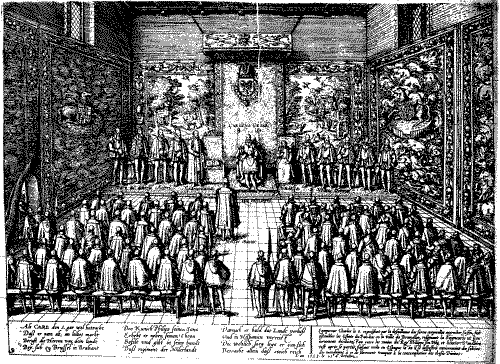
- Jacques Le Boucq, "Eschauffault de la confrarye de la goude", en Le tresad- / mirable tri- / umphe de la / noble Order- / de la Thoi- / son dor / Chelebree de La / florisantte Ville / danvers Ian 1555 / Par Treshault & / Tresillustre Prince / Philippes Daustrice / Roy despaigne dangle- / terre de france & / duc de bourgoigne , f. 14 y 14v. Archivos del Toisón de Oro, Viena, cod. 24, Haus-, Hof- y Staatsarchiv (59 pages), 270 x 210 mm, Valenciennes, 12 de marzo de 1556.
- Cabrera de Córdoba, Historia de Felipe II, rey de España, lib. I, cap. VII, pp. 30s, 1601; ed. Junta de Castilla y León, Salamanca, 1998.
- Antonio de Herrera, Historia general del mundo de XVII años del tiempo del señor rey don Felipe II..., lib. II. cap. XVII, pp. 125-129, Valladolid, por Juan Godinez de Millis, 1606.
- E. Roobaert, "De triomfbogen opgericht te Antwerpen in 1556, ter gelegenheid van het 22ste kapittel van de Orde van het Gulden Vlies", en Bulletin Koninklijke Musea voor Schone Kunsten van België, p. 221-276, XI , 1962.
- Fernando Checa Cremades, "La formación del príncipe Felipe", en Felipe II, mecenas de las artes, p. 20 y 469, Nerea, Madrid, 1992. Although we take originally of this great book this information, it includes some errors, as locating the parties of the Chapter of the Golden Fleece in Brussels in 1555, when they took place in Antwerp in 1556. The tableaux vivant of the Chambre of Rhétorique of Antwerp (not of Gouda) called themself «de Goudbloem» (the Golden Flower). The complete text of the Latin inscription was: «Vivat rex, Benedictus dominus deus israel quy dedit hodie sedentem in solio meo videntibus oculis meis; Ut quondam David procerum plaudente senatu / arce sua natum regali in sede locavit / carolus augustus modo sic permisit habenas / filius ut regni plena ditione teneret / gaudet et ingenti nunc ergo antverpia plausu / Laetisonusq. tuba fecit aurea sidera clangor».
1.3. Dirck Crabeth: «The consecration of Salomón's Temple» (Gouda, 1555-57)
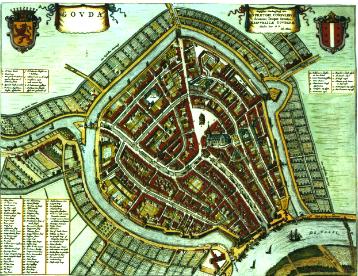
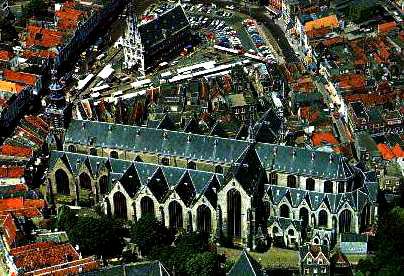
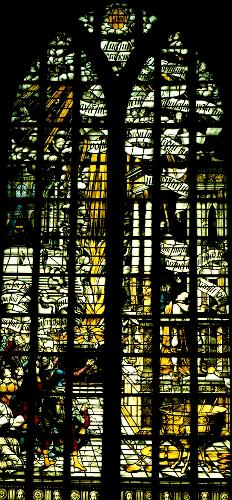
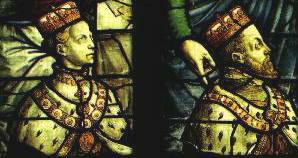

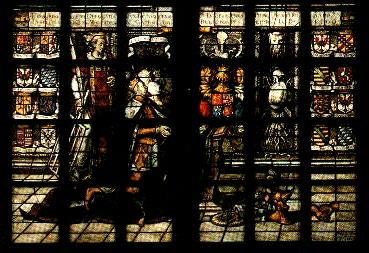
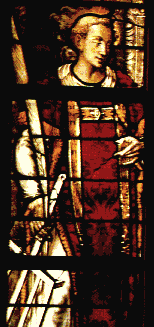
1.4. Josefo's «Wars of Jews» (Antwerp, 1557)
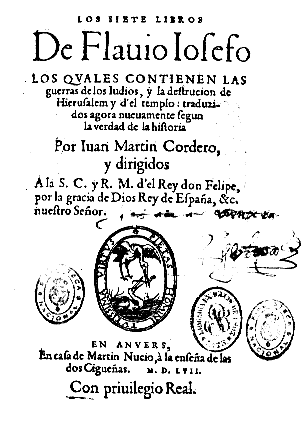
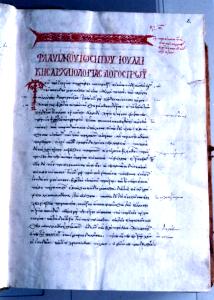
------------------------------------------------------
Flavio Josepho's seven books Of Beautiful Jewish the quales the Wars of the Iudíos and the destruction of Hierusalem and d contain ' the Temple. Juan Martín Cordero, Martín Nuncio, Anvers, M.D.LVII. Orig., Rome, 79 d.C.
1.5. Exequias of Emperor Charles V (Brussels, 1558)
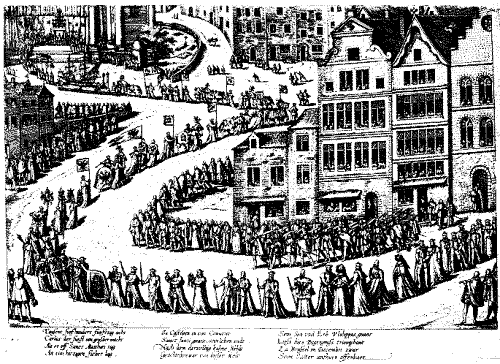
1.6. Wouter Crabeth: «King Salomón receives the Queen of Saba» (Gouda, 1559-61)
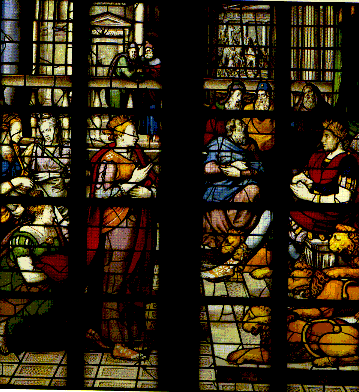
1.7. Lucas of Heere: «the queen's visit of Saba to king Salomón» (Gante, 1559)

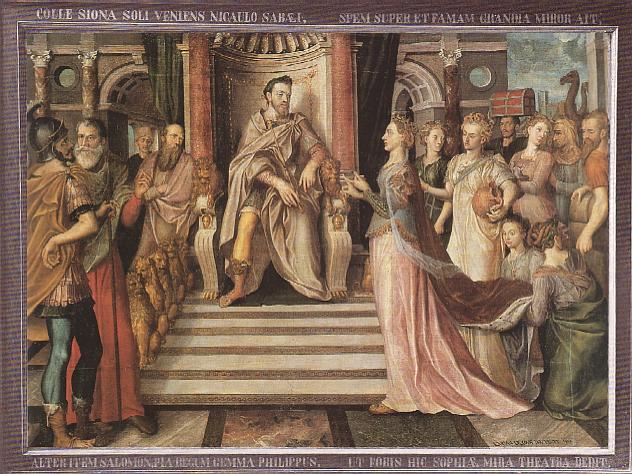
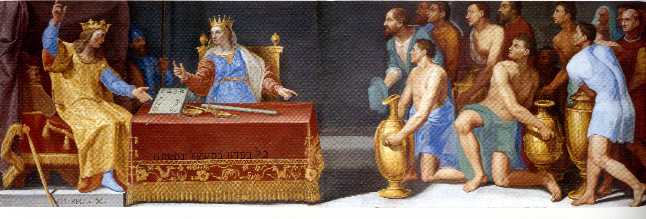
1.8. Hendrick Goltzius: «Salomo's Oordeel»
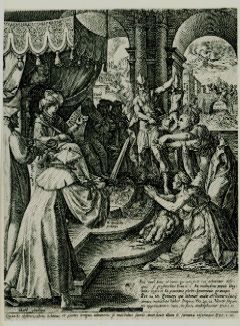
------------------------------------------------------
Catalog of the exhibition Ketters in Papen onder Filips II", p. 109, in the Catharijneconvent, Utrecht, 1986